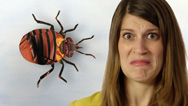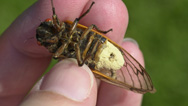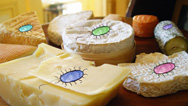The World’s Priciest Fungus
- Posted 07.07.16
- NOVA
The most expensive fungus in the world is likely a parasite growing from a caterpillar’s head. Find out why the fungus is so coveted in this episode of Gross Science.
Transcript
The World's Priciest Fungus
Posted: July 7, 2016
Believe it or not, one of the world’s most coveted status symbols is a caterpillar with a fungus growing out of its face.
I’m Anna, and this is Gross Science.
On the Tibetan Plateau and the Himalayas, ghost moth caterpillars live underground, keeping warm and eating plant roots til they turn into adult ghost moths.
That is, unless they get infected with the fungus Ophiocordyceps sinensis . The fungus enters a caterpillar’s body in summer or autumn, and it starts to grow in threads through the caterpillar’s organs, eating it from the inside out. Brainwashed by the fungus, the caterpillar crawls upward until it’s just below the surface of the soil, where it dies.
In the spring, a long, brown fungal stalk bursts from the caterpillar’s head. It pops through the soil to send out its spores, which infect other caterpillars—and the circle of life and parasitism continue.
Now, you might think that’s the end of the story, but people scour the meadows where the fungus grows, hoping to harvest these infected corpses. Why? Well, a pound of the fungus, called yartsa gunbu, can be worth tens of thousands of dollars. In fact, it’s probably the most valuable fungus in the world. That’s because it’s used in traditional Chinese and Tibetan medicine to slow aging, cure cancer, and treat all kinds of other diseases. It’s even sold as an aphrodisiac.
The science is still out on whether eating yartsa gunbu actually does anything good for your health. But, harvesting it is definitely bad for the fungus. It’s a huge status symbol in China, and people have collected so much Ophiocordyceps sinensis that it’s now endangered in some places.
And, this isn’t just a problem for the parasite, or for the people who eat it or brew it in tea. Yartsa gunbu is a big part of the economy in places where it’s harvested, like Tibet and Nepal. So, local communities are trying to figure out ways to sustainably harvest the fungus. Because for them, this is one parasite that’s worth protecting.
I still feel kind of bad for the caterpillar though.
Ew.
Credits
PRODUCTION CREDITS
- Host, Animator, Editor
- Anna Rothschild
- Writer
- Elizabeth Preston
- Camera, Sound
- Seeta Joseph
- Quirky Idea
- Music Provided by APM
- © WGBH Educational Foundation 2016
FOOTAGE AND IMAGES
- Caterpillar Fungus 2
-
Filmographer:
Rdo rje don 'grub རྡོ་རྗེ་དོན་འགྲུབ།
(Duojieduanzhi)
Flickr/Koknor Koknor - Cordyceps sinensis in ground
-
Exposed 2008 and Bu Finding BarLa288
© Daniel Winkler
http://mushroaming.com - Weighing Caterpillar Fungus
- Wikimedia Commons/Mario Biondi
- Soup of Silkie Seahorse and Cordyceps
- Wikimedia Commons/Kent Wang
- Mountain yak penis, fungus as Chinese medicines
- Wikimedia Commons/Angela Schmeidel Randall
- Cordyceps Sinensis
- Wikimedia Commons/Rafti Institute
- Caterpillar Fungus Store, Central Lhasa
- Flickr/Erik Törner
- Duck Tales, Alice in Wonderland, Mario Gifs
- Giphy
- SFX
- Cockroaches
-
Freesound/StateAardvark
(used with permission from author) - Squeak Pack/squeak_10
- Freesound/Corsica_S
- Jawharp Boing
- Freesound/plingactivator
- Swish Unwrap Fast
- Freesound/goldendiaphragm
- RAM_Mouth Hawk_rev_v1
- Freesound/Reidedo
- Male drinking slurping aaaaaaaaaaah small belch
- Freesound/Anton
- Tape Pulling Off Surface
- Freesound/Baryy
- MouthPop
- Freesound/HerbertBoland
- Produced by WGBH for PBS Digital Studios
Sources
Want more info?
NPR—Caterpillar Fungus: The Viagra of the Himalayas:
http://www.npr.org/2011/10/09/141164173/caterpillar-fungus-the-viagra-of-the-himalayas/
National Geographic—Caterpillar Fungus Has Anti-Inflammatory
Properties:
http://news.nationalgeographic.com/news/2012/121128-caterpillar-fungus-swelling-animals-science/
Cochrane—Cordyceps sinensis (a Chinese medicinal
herb) for treating chronic kidney disease:
http://www.cochrane.org/CD008353/RENAL_cordyceps-sinensis-a-chinese-medicinal-herb-for-treating-chronic-kidney-disease/
Science Alert—The parasitic fungus is worth more than its
weight in gold:
http://www.sciencealert.com/this-parasitic-fungus-is-worth-more-than-its-weight-in-gold/
Nature—Asian medicine: A Fungus in decline:
http://www.nature.com/nature/journal/v482/n7383/full/482035b.html
Related Links
-

Gross Science
Bizarre stories from the slimy, smelly, creepy world of science.
-

Butt-less Cicadas
The fungus Massospora cicadina makes periodical cicadas’ butts fall off.
-

What Lives in Cheese?
What makes cheese so delicious? It's the bacteria, fungi, mites, and maggots living in it.
-

Plants with Family Values
Scientists find that plants can act altruistically toward their siblings.

